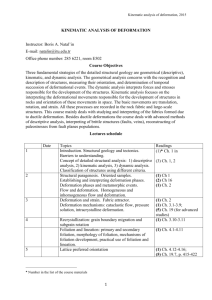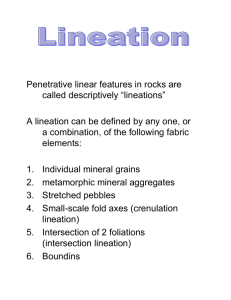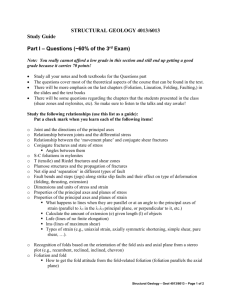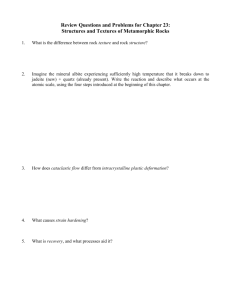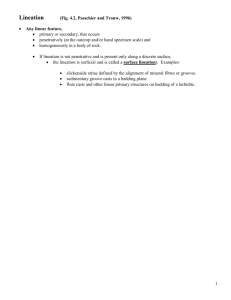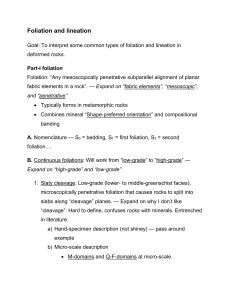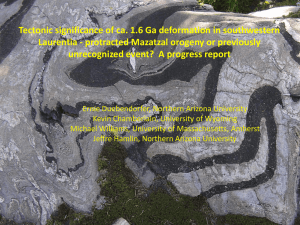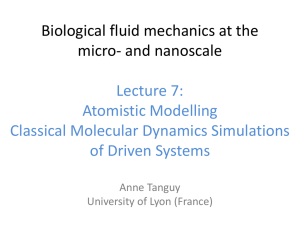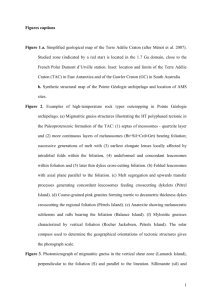Foliations and Lineations
advertisement
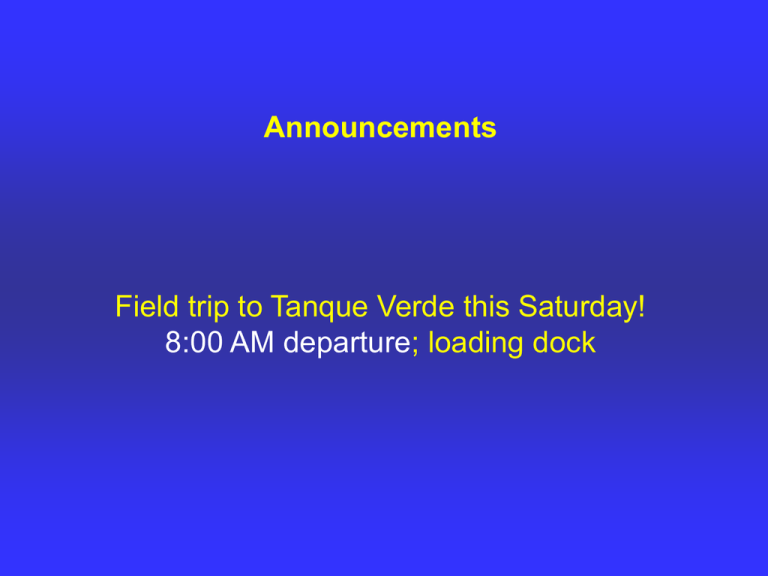
Announcements Field trip to Tanque Verde this Saturday! 8:00 AM departure; loading dock In brittle regime: joints, tensile fractures, shear fractures (faults!), pressure solution (cleavage development)deformation mechanisms depend on pressure! What about deformation in the deeper crust? Today: Foliations, stretching lineations, and tectonites- deformation in the deeper crust (D&R, pp. 456-479; 485-492) "General" definition: Foliation: Penetrative (at outcrop and microscopic scale) and parallel planar fabric elements in a rock. "Structural geologist's" definition: Planar fabric is secondary and due to mineral recrystallization and/or plastic behavior during deformation at elevated temperatures phyllitic structure is a type of foliation Schistosity: coarser grained fabric- also a foliation Gneissic structure: Compositional banding produced during deformation. Migmatite: Compositional banding due to insitu partial melting. Swirly appearance In a conglomerate, flattened pebbles may define a foliation- "flattening fabric" Flattening of strong layers surrounded by weak layers may cause strong layers to "neck" and form boudins. more boudins Boudins in 3-D Mylonitic foliation: Forms due to grain-size reduction by a mix of brittle and plastic deformation in shear zones brittle deformation of feldspar porphyroclasts plastic deformation of quartz "ribbons" and mica Coarse-grained mylonitic augen gneiss. The large porphyroclasts are called augen ("eyes") A strongly mylonitized rock- note the extremely fine grain size due to "pulverization" during shearing Lineation: penetrative linear fabric. We will focus on those that are related to deformation. How does it differ from other linear structures we have talked about, like slickenlines on a fault surface? Types of lineations: 1) Intersection 2) Crenulation 3) Mineral 4) Stretching Intersection lineation: Intersection of two planar features- an "apparent" lineation in that there is no fabric that is linear. e.g., intersection between cleavage and planar surface Crenulation lineation: Intersection between fold hinges and foliation Mineral lineation: preferred alignment of minerals due to deformation and/or recrystallization during deformation Stretching lineation: elongation of minerals due to "stretching" deformation Stretched calcite Lineation defined by stretched pebbles in a conglomerate Tectonites: Rocks that are pervaded by foliation and/or lineation- flowed in solid state S: Schistosity (foliation) only due to flattening- no lineation L: Lineation only, due to unidirectional stretching/ constriction LS: Foliation and Lineation, related to noncoaxial strainshearing Strain ellipse and tectonites S-tect = S1= S2 > S3 (coaxial) L-tect = S1 > S2 = S3 (coaxial) LS-tect = S1 > S2 > S3 (non-coaxial) What kind of tectonite is this? Coaxial (pure shear) or noncoaxial strain? What is it? L-tectonite Coaxial What kind of tectonite is this? Coaxial vs. non-coaxial? L-S tectonite non-coaxial S-C fabrics- occur in L-S tectonites and serve as excellent sense-of-shear indicators S-Surfaces- planes of schistosity/foliation (flattening) C-Surfaces- planes of maximum shear "shear bands" C comes from cisaillement, French for shear When studying S-C fabrics- must look perpendicular to lineation! S-C fabrics and the strain ellipse First step- find shear bands (C-surfaces) Second step- find flattening planes (S-surfaces) Third step- sense of shear from strain ellipse! left-lateral sense of shear Practice! top to right sense of shear S C For fine-grained mylonites- S-C fabrics can be studied using a microscope Saturday's field trip to Tanque Verde Wash (Redington Pass area) A look at deformation in a shear zone related to the Catalina detachment Hypothesis for evolution of metamorphic core complexes including the Catalina-Rincon core complex and detachment system. Next Lecture: Shear zones and shear sense indicators Please read (D&R, pp. 493-551) Important terminology/concepts foliation gneissic structure migmatite boudins mylonites augen gneiss lineation (intersection, crenulation, mineral, stretching) tectonites (L, S, L-S) tectonites and strain ellipsoid S-C fabrics and sense-of-shear Structural evolution of metamorphic core complexes
